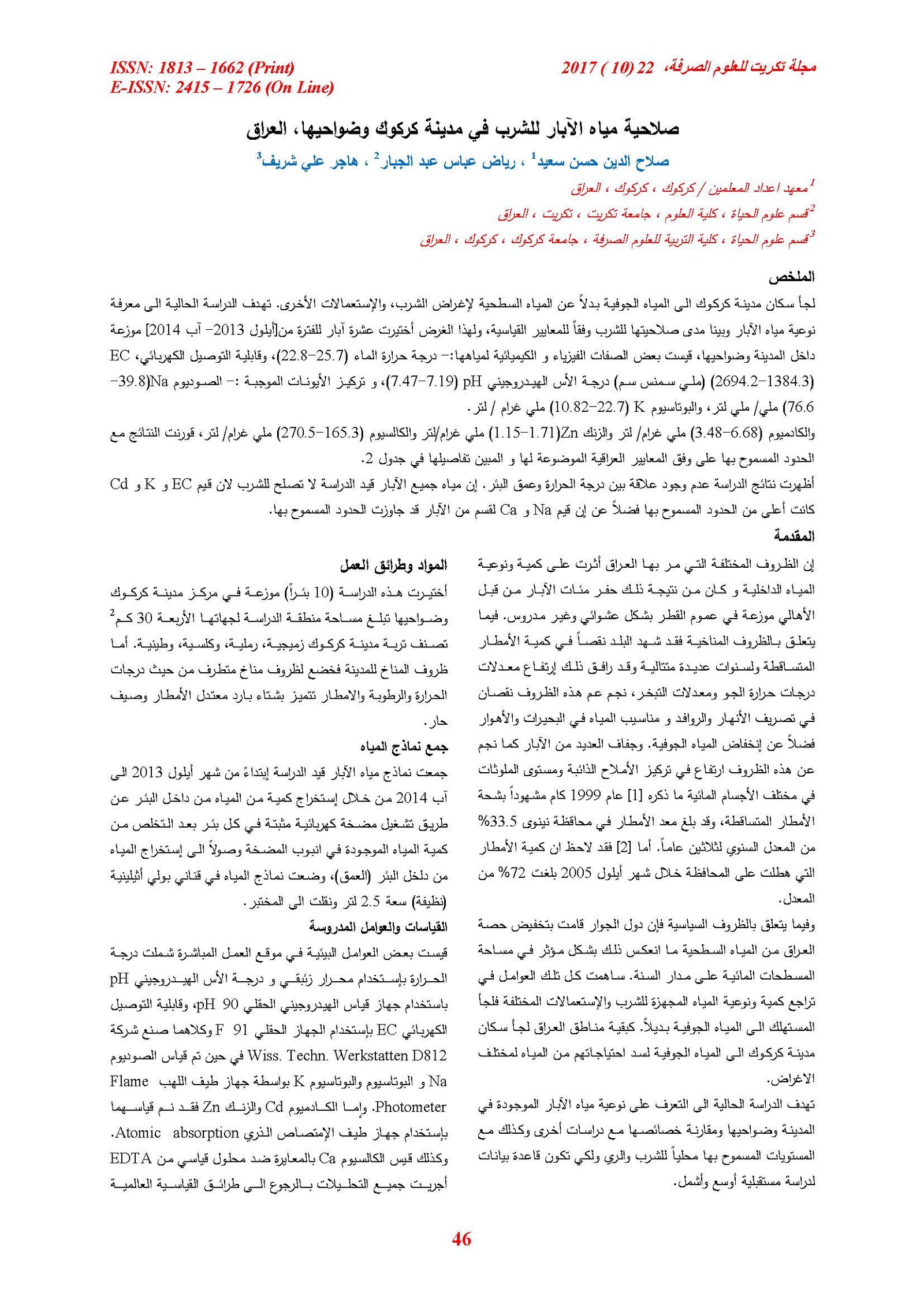Potability of well water in Kirkuk city Iraq
Main Article Content
Abstract
The Kirkuk residents had resorted underground water as an alternative to the surface water the present study aims to indicate the quality of these water and demonstrates extent of their suitability drinking. For this purpose, 10 randomly distributed wells were measured, the average values 10 well were as follows:
Water temperature (22.8-25.7 Co), EC (2694.2-1384.3 sem/cm),PH(7.47-7.19) and concentration of cation’s: Na (76.8-39.8 mg/L), K (10.82-22.7 mg/L), Zinc (1.15-1.71 mg/L), cadmium (3.48-6.68 mg/L) and Calcium (270.5-165.3 mg/L).
These characters are ties were compared with the allowed limits presented by concerned authorities the results of the study indicated the absence of any results ship between temperature and depth of the wells.
Also water’s of all studied wells were not suitable of drinking as the EC, K, and cadmium were higher than allowed limits.
In addition, Na and Ca concentrations of some wells exceeded the allowed limits
Article Details

This work is licensed under a Creative Commons Attribution 4.0 International License.
Tikrit Journal of Pure Science is licensed under the Creative Commons Attribution 4.0 International License, which allows users to copy, create extracts, abstracts, and new works from the article, alter and revise the article, and make commercial use of the article (including reuse and/or resale of the article by commercial entities), provided the user gives appropriate credit (with a link to the formal publication through the relevant DOI), provides a link to the license, indicates if changes were made, and the licensor is not represented as endorsing the use made of the work. The authors hold the copyright for their published work on the Tikrit J. Pure Sci. website, while Tikrit J. Pure Sci. is responsible for appreciate citation of their work, which is released under CC-BY-4.0, enabling the unrestricted use, distribution, and reproduction of an article in any medium, provided that the original work is properly cited.
References
4. Dinelli, E.; Comtecci, G.; Lucchini, F. and
Zantedeseh, E. (2005). Sources of Major and Trace
Elements in the stream sediments of the Arno River
catchments, Northern Tuscany, Italy. J. Geochrem.
39;531-545.
5. Lutgen, F., K, Tarbuck, J. and Tasa, Dennis.
(2012). Essentral of geology. 11th Edition: pearson
Education, Inc. USA: 578 pp.
6. APHA (American puplic Health Association).
(2011). Standard Methods for the Examination of
water and Wastewaters. 20th Edition.
7. Owa, F. D. (2013). Water pullution: Sources.
Effeccts, Control and Management. M editerranean
J. of Sci.( 4) 81:65-68.
9. Tim. (2002). Fundamentals of Hydrology. Second
Edition: Routledge Fundamentals of Physical
Geography. USA and Canada: Routledge: 200 pp.
10. UNEP / WHO. (2011). Water quality monitoring
- apractical guide to the design and implementation of
freshwrater quality studies and monitoring
programmers. Edited by Jamie Bartram and Richard
Balance.
11. Al-Naqishbandi L. M; Toma, J.J and Mauloud,
B. K. (2008). A Study on Water Quality in Makhmur
Area, Kurdistan, Iraq. Zanco. 20(2):154-5.
12. Tomar, M.(1999). Quality assessment of water
and wastewater: Lewis Publisher.
16. TCOEQ (Texas Comession on enviromental
Quality). (2015). Drinking Water Standards
Governing Drinking Water Quality and Reporting
Requirements for public water systems.
17. USWPA (United States Enviromental Protection
Agency. (2004). Drinking Water Standards and
Health Advisories office of water Washington United
States Enviromental Protection Agency. Washington
D.C.
